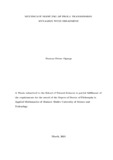| dc.description.abstract | Ebola Virus Disease, (EVD) is a rare and deadly disease with high fatality rates in humans and other primates. It is introduced into the human population through direct contact with the infected hosts which include porcupines, fruit bats, chimpanzees, gorillas, monkeys and forest antelopes. Transmission from one human being to another takes place via direct contact with body fluids of the infected or indirectly via surfaces contaminated by these fluids. Mathematical models have been developed describing between host and within host dynamics of EVD separately. The within host models of EVD have considered mass action incidence rate which does not capture the effect of saturation due to high concentration of Ebola virions. As a result, a within host model incorporating saturated incidence rate and treatment has been developed and analysed. Stability analyses of the model developed show that the Infection Free Equilibrium (IFE) is locally and globally
0 > 1, an Endemic Equilibrium (EE) emerges,
asymptotically stable, if R
0 < 1, and when R
w
w
which is unique and globally asymptotically stable. The effect of treatment has been illustrated using numerical simulations. One of the control strategies of EVD is vaccination. The between host models of EVD incorporating vaccination available in literature assume that the vaccines grant full immunity. This may not be the case since the vaccines are still under development. Consequently, this study has developed and analysed a Susceptible Exposed Infected Recovered (SEIR) model incorporating an imperfect vaccine. Analyses
B
of its equilibrium points have shown that if the basic reproduction number , R
0 < 1,
the disease dies out and if R0B > 1, the disease persists in the population. The impact of vaccination on the disease has also been established. Even though separate models have been used to study immunological and epidemiological dynamics of EVD, studies have shown that for virus infections, the infectivity of the host is directly proportional to the viral load. This therefore calls for the use of a multiscale model to capture this interdependence between scales. Multiscale models of EVD exist. However, they have not considered uninfected cells and infected cells, yet they are major players in the within host dynamics of EVD. This study therefore has formulated a multiscale model of EVD incorporating the uninfected cells, infected cells and the Ebola virions. Analyses of the Disease Free Equilibrium (DFE) and the EE show that the disease dies out if the basic reproduction number R0c < 1 and persists in the population when R0c > 1 respectively. Sensitivity analysis shows that the rate and efficacy of vaccination are the most sensitive parameters. This indicates that effort should be directed towards implementing an effective vaccination strategy to control the spread of the disease. It has also been established through simulations that when treatment efficacy is scaled up, the viral load goes down within a host and consequently, the transmission between hosts is also reduced. The models developed and analysed in this study have a significant impact on the control of EVD. | en_US |

